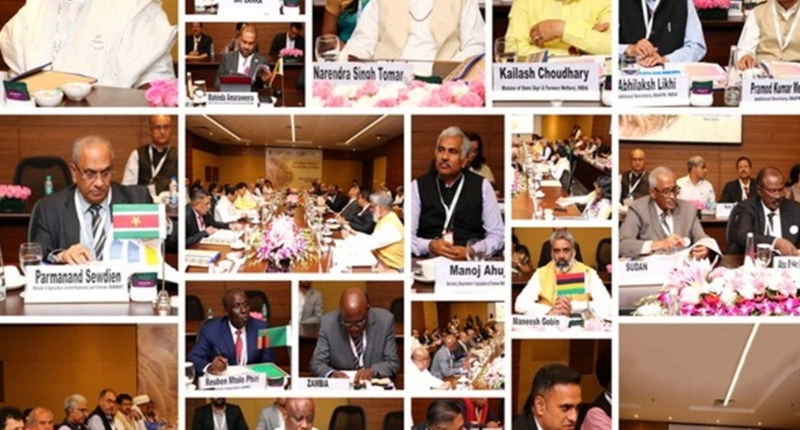India hosted the Global Millets (Shree Anna) Conference in Delhi to celebrate the International Year of Millets in 2023. The conference aims to raise awareness of the importance of millets for food security and nutrition and promote research and development. Ministers from various countries attended the ministerial roundtable on millets in New Delhi, where they shared their respective countries’ experiences in promoting millet production, consumption, and branding. Millets are small-seeded grasses that offer nutrition, resilience, income, and livelihood for farmers and have multiple uses. India is the largest producer and second-largest exporter of millets globally and produces all nine commonly known millets. The Indian government has been implementing a Sub-Mission on Nutri-Cereals (Millets) under the National Food Security Mission to promote millets and meet the additional demand for millets. The Indian government is also encouraging the formation of farmers’ associations, such as FPOs, to increase aggregation, production, and processing.
India Hosts Roundtable on Millets for Global Production and Consumption Strategy
India hosted a ministerial roundtable on millets on Saturday after the inaugural session of the Global Millets (Shree Anna) Conference in New Delhi. The conference is being held to celebrate 2023 as the International Year of Millets (IYM). The United Nations declared 2023 as the IYM on India’s initiative to raise awareness of millets for food security and nutrition, promote research and development, and encourage stakeholders to improve millet production, productivity, and quality.
Ministers from six countries, including Guyana, Mauritius, Sri Lanka, Sudan, Suriname, and Zambia, as well as the Permanent Secretary of Agriculture of Gambia and Maldives and the Director General of Millets Initiative Nigeria, participated in the meeting. During the ministerial roundtable, India’s role in promoting millets as the world’s largest producer and second-largest exporter was highlighted by Union Minister of Agriculture and Farmers Welfare, Narendra Singh Tomar.
Tomar also mentioned the Indian government’s implementation of a Sub-Mission on Nutri-Cereals (Millets) under the National Food Security Mission (NFSM) in 212 districts of 14 states since 2018-19. The mission aims to promote millets and meet the additional demand for millets. India exported 104,146 metric tonnes of millets worth Rs 365.85 crore during the export year 2022-23 (April to November).
The visiting ministers from major millet-producing countries shared their respective countries’ experiences in promoting millet production, consumption, and branding. They all supported closer collaboration among major millet-producing countries and favored India’s provision of good seed of improved millet varieties, establishment of small-scale mechanization and capacity building. The ministers also expressed their desire to promote indigenous millet crops in their countries to free people from wheat consumption.
The conference was inaugurated by Prime Minister Narendra Modi, who expressed his hope that the conference would help promote the health and well-being of people around the world. The Indian government is encouraging the formation of farmers’ associations, such as FPOs, to increase aggregation, production, and processing. Tomar expressed happiness at the operation of many startups in millets with government support.
India Hosts Global Millets Conference to Raise Awareness on Millets
India recently held the Global Millets (Shree Anna) Conference in Delhi, marking the start of the International Year of Millets (IYM) in 2023. The Indian government spearheaded the United Nations General Assembly (UNGA) resolution, which was supported by 72 countries, to declare 2023 as the IYM to raise awareness on the importance of millets for food security and nutrition, promote research and development, and encourage stakeholders to improve millet production, productivity, and quality.
Ministers from Guyana, Mauritius, Sri Lanka, Sudan, Suriname, and Zambia, as well as the Permanent Secretary of Agriculture of Gambia and Maldives, and the Director General of Millets Initiative Nigeria, attended the ministerial roundtable of millets in New Delhi. The visiting ministers shared their respective countries’ experiences in promoting millet production, consumption, and branding, and all supported closer collaboration among major millet-producing countries.
Millet is a term for small-seeded grasses, often called Nutri-cereals, which include sorghum, pearl millet, finger millet, little millet, foxtail millet, proso millet, barnyard millet, and kodo millet. Millets offer nutrition, resilience, income, and livelihood for farmers and have multiple uses such as food, feed, fodder, biofuels, and brewing. Millets are nutritionally superior to wheat and rice due to their higher protein levels, a more balanced amino acid profile, and various phytochemicals that exert therapeutic properties.
India produces all nine commonly known millets and is the largest producer and second-largest exporter of millets globally. To promote millets and meet the additional demand for millets, the Indian government has been implementing a Sub-Mission on Nutri-Cereals (Millets) under the National Food Security Mission (NFSM) in 212 districts of 14 states since 2018-19. In addition, the Indian government is encouraging the formation of farmers’ associations, such as FPOs, to increase aggregation, production, and processing.
The visiting ministers requested that millets be declared priority crops and set the agenda in all international meetings. India assured these countries to provide all knowledge, technology, and capacity building. Some countries like Guyana, which are not traditional millets growers, have shifted to millets cultivation due to awareness created by the International Year of Millets.
Before the Green Revolution, millets made up around 40% of all cultivated grains in India, which has dropped to around 20% over the years. Millet production is not dependent on the use of chemical fertilizers, making it more environmentally friendly. The Indian government’s efforts to promote millet production aim to revive the traditional grain’s consumption and benefit the farmers who cultivate it.
Don’t miss interesting posts on Famousbio









